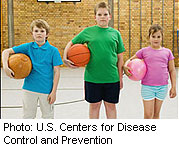Exercise Programs for Kids Seem to Have Little Impact: Study
But other experts disagree and say more activity, not less, is needed

THURSDAY, Sept. 27 (HealthDay News) -- Formal physical exercise programs for children have only a small impact on overall activity and thus on weight loss, British researchers report.
Their study raises questions about the best ways to help children attain or maintain a healthy weight.
"Physical activity interventions are not increasing physical activity sufficiently to impact on the body mass or body fat of children," said lead researcher Brad Metcalf, of the department of endocrinology and metabolism at Peninsula College of Medicine and Dentistry in Plymouth, England. "It is in everyone's interest to find something that works effectively," he added.
But other experts said instead of dismissing organized interventions as ineffective, policymakers should conclude that still more is needed to stem childhood obesity. In the United States, about 17 percent of children aged 2 years and older are obese.
"I disagree that the importance of physical activity to childhood obesity control, or health promotion, has been called into question by this study," said Dr. David Katz, director of the Yale University Prevention Research Center in New Haven, Conn.
On the contrary, "we have cause to question if we are doing enough to make routine activity the cultural norm, so that such programming can achieve greater effects," Katz said. "An intervention, no matter how good, can only achieve so much if not surrounded by cultural supports."
Katz also faulted the study for not including data from the many studies that show a significant benefit from exercise.
For the study, published in the Sept. 27 online edition of the BMJ, the researchers analyzed 30 studies conducted between 1990 and 2012 involving children aged 16 and under.
This type of study, known as a meta-analysis, is used to find common threads running through multiple studies. Problems with this type of analysis can arise from the weakness of any of the studies included and the difficulty of combining disparate data.
Unlike some other studies of children's activity, these studies measured actual movement during children's waking hours using accelerometers and didn't rely on questionnaires.
Eight of the 30 studies included only overweight or obese children. One U.S. study followed more than 700 children, average age 11, taking part in 90 minutes of after-school physical activity three times a week. Another involved more than 250 Scottish nursery school children who did 30 minutes of physical activity three times a week.
Overall, the researchers said the programs achieved "small-to-negligible" increases in children's total activity with small improvements in time spent in moderate or vigorous intensities -- about four minutes' walking or running per day.
This could have only a minimal effect on weight, they concluded.
"It's been shown by others that four minutes extra walking/running is only associated with a 2 millimeter difference in waist circumference," Metcalf said. While the added activity sessions might offer other benefits, including better coordination, improved ability at a sport, team participation and genuine enjoyment, they won't "have a meaningful impact on obesity prevention," he said.
These programs may not work because they might replace physically demanding after-school activities that take place outdoors and last for longer periods, the researchers said. It's also possible that children eat more after these sessions, they noted.
Mark Hamer, from the department of epidemiology and public health at University College London and co-author of an accompanying journal editorial, said the study has limitations but "provides the best evidence to date on the effectiveness of physical activity interventions in childhood."
Better approaches to increasing children's physical activity are needed, Hamer said. Perhaps physical changes to the indoor and outdoor environment can facilitate activity, he suggested.
He and others maintain that a wealth of evidence supports the association between an active lifestyle and better health.
Samantha Heller, exercise physiologist and clinical nutrition coordinator at the Center for Cancer Care at Griffin Hospital in Derby, Conn., pointed out that programs that aim to boost children's activity levels may not influence sedentary behavior at home or once the programs conclude.
Also, "many interventions do not include a nutrition component that could impact food choices, overall nutrition or calorie intake," she said.
School environments need to shift toward a more active day for kids, Heller said. "We need to continue to develop programs, environments and classes that encourage and educate children and teens on the importance of exercise and physical activity in ways that are meaningful and fun for them," she added.
More information
For more information on childhood obesity, visit the U.S. Centers for Disease Control and Prevention.

|